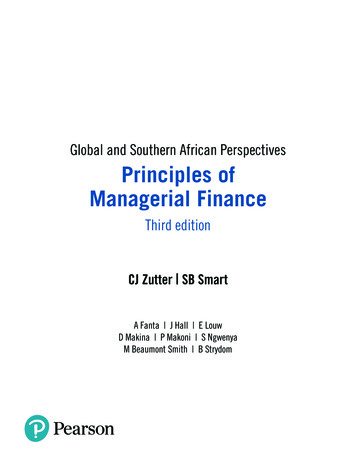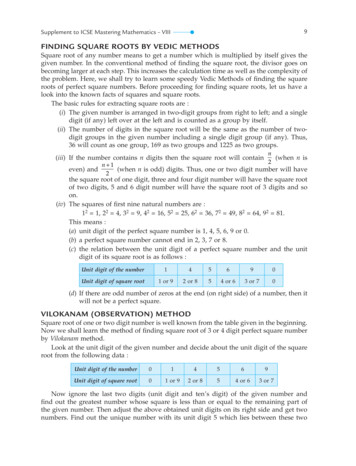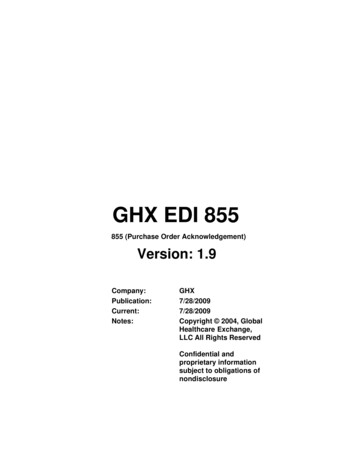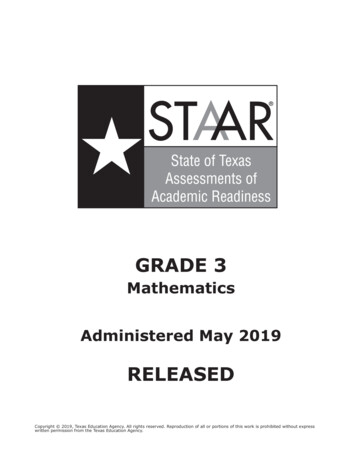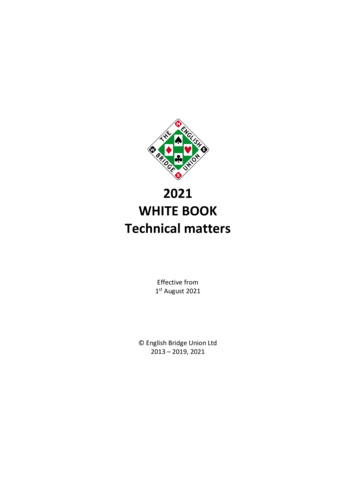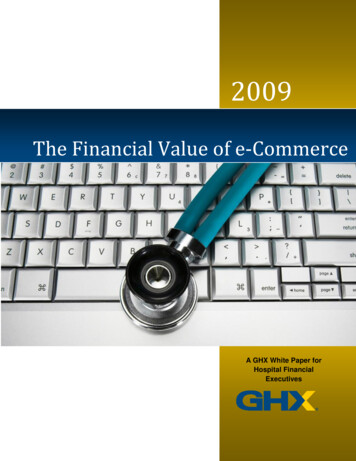
Transcription
2009The Financial Value of e-CommerceA GHX White Paper forHospital FinancialExecutives
The Financial Value of e-CommerceThe Financial Value of e-Commerce:Beyond Productivity to Hard Dollar Savings2009Key FindingsHospitals using GHX report saving 76,000Hospital chief financial officers (CFOs) understand the impact of thesupply chain on the bottom line. Short of becoming a supply chainexpert, how best can a financial executive foster changes that drivereal contributions through hard dollars savings? This is the first in aseries of white papers designed to provide insight into the supplychain from a financial perspective.to 500,000 annually by being able to payThis first paper will specifically explore opportunities enabled bysupply chain automation, beyond labor savings and increasedproductivity. Hospitals are documenting quantifiable hard-dollarsavings through e-commerce by optimizing business processesaround visibility to real-time data. By looking past the obvious, thevalue of automating manual processes, they can often achievefinancial results beyond whatwas originally anticipated.Hospitals are documentingSubsequent papers willquantifiable, hard-dollarexplore how to further buildsavings from e-commerce byupon that foundation, withoptimizing business processtopics ranging from: contractaround visibility to real-timecompliance and optimization,data.AP automation, and thepurchase and utilization ofphysician preference items,which constitute the fastest growing expense for most hospitals.takes to pay suppliers from an average ofsuppliers faster and take advantage of earlypay discounts.Fewer invoice exceptions and moreelectronic invoices can reduce the time it15 to 60 days to just two to five days.By correcting purchase order exceptions inreal time, hospitals can reduce invoiceexceptions by 33 to 50 percent.Real-time exception management reducesoverpayments to suppliers, as well as rushorder and freight charges.With real-time exception management, anorder sent via GHX costs 55 to 70 percentless to process than a traditional EDI orderand 70 to 80 percent less than a manualorder.Validating contract pricing during theFinding Value beyond AutomationCost savings opportunities made possible by automating businessprocesses are well-recognized by hospital executives. A recentHealthcare Financial Management Association (HFMA) surveyrecorded a 60 percent increase in the number of respondents whoconsider automation a good opportunity for supply chainimprovement. In that same survey, automation still ranked relativelylow compared to other initiatives, including gaining physician/clinicianbuy-in, data standardization, and integrating the supply chain and therevenue cycle. However, many hospital executives still don’trecognize how supply chain automation and e-commerce can supportand maximize the effectiveness of those more highly rankedinitiatives. To better understand this point, we must look more closelyat how e-commerce initiatives can translate into both labor and harddollar savings.purchasing process enables hospitals tosave one to three percent of the totalamount they spend on contracted items.Visibility into items on contract reducesmaverick purchases that can otherwiseincrease supply costs 5 to 20 percent.
The Financial Value of e-Commerce2009The First Opportunity: Lower Connectivity CostsMany hospitals initially decide to join an exchange in order to reduce costs related to supplier connectivity. On average,hospitals report that by connecting electronically to multiple trading partners through a single exchange, they can avoidbetween 1000 and 3000 per supplier connection for costs associated with IT labor, hardware and software, andtelecommunications fees, some of which are ongoing. Those savings can be significant, especially for hospitals that havedramatically increased their number of electronic trading partners by connecting to the GHX Exchange. The averagenumber of supplier connections per integrated delivery network (IDNs) using GHX is 35, but some provider organizationshave connected to more than 100. With just 50 supplier connections, a hospital can lower its connectivity costs by 50,000 to 150,000.Using browser-based and fax conversion tools, hospitals using GHX can also conduct business electronically withsuppliers that do not have an EDI infrastructure and with whom they would otherwise only be able to place ordersmanually. Through a combination of connectivity solutions, some healthcare organizations are transacting business withas many as 600 electronic trading partners via GHX.Improved Business Processes Enabled by Real-time Data VisibilityMore trading partners increases the percentage of purchases that hospitals can handle electronically. More electronicpurchasing, in turn, not only saves time but also increases the availability of real-time supply chain data to improvebusiness processes.The following chart demonstrates the areas of labor savings made possible by processing an order via GHX, which is onaverage between 70 to 80 percent less expensive than a manual order.Manual OrdersGHX Orders*Industry average savings calculated from weighted averages for 120 hospitals.
The Financial Value of e-Commerce2009Exception Management: Lowers Processing Costs/Enables Hard Dollar SavingsMost people recognize that an electronic order is considerably less expensive to process than a manual order. What issurprising to many is that the cost of processing an order through GHX is often 55 to 70 percent less expensive than anelectronic order sent direct to a supplier via EDI. A typical GHX order with discrepancies costs 6.70 compared to asimilar order sent via EDI at a cost of 22.61. That translates to a savings of 16,000 for every 1000 orders.Total Cost Comparison*ManualEDIGHXDiscrepant Order 34.51 22.61 6.70Accurate Order 16.60 10.51 4.66*Industry average purchase order costs calculated from weighted averages for120 hospitals.The cost difference has nothing to do with how the order is sent to the supplier. In fact, most orders sent via GHX are EDItransactions. The difference stems from how buyers utilize real-time data made available through GHX to manage thoseorders. With traditional EDI orders, buyers may or may not receive order confirmations from suppliers, and if they do, theymay still have to review and reconcile those confirmations to the purchase order line-by-line to identify any discrepancies.The GHX My Exchange Order Center notifies buyers in real-time when there are order exceptions. Orders withoutdiscrepancies can continue through the process in a touchless manner. With traditional EDI, buyers must perform a lineby-line match, even for orders without discrepancies, a process that can take 2 to 10 minutes per order.With MyExchange OrderCenter, buyersare notifiedaboutdiscrepancies inreal time andcan click to findout moreinformation andcorrect anyproblems.
The Financial Value of e-Commerce2009On average, buyers say they save approximately 2 hours per day by being able to automate the exception managementprocess. More importantly, with proactive exception notification, buyers can correct purchase orders during thetransactional process and avoid costly invoice exceptions.Hard Dollar Savings: Early Pay DiscountsReducing invoice exceptions translates into hard dollar savings, most notably by enabling hospitals to take advantage ofearly pay discounts from suppliers. On average, hospitals report a 33 to 50 percent reduction in invoice exceptions usingGHX. When there is an exception, the additional time spent reconciling the invoice can add another 5 to 20 days to thetime it takes to pay the supplier. When there are no exceptions, hospitals, if they choose, can pay suppliers immediately.This not only saves time, but also money. Hospitals have reported that by working with GHX they have been able togenerate savings ranging from 76,000 to 500,000 annually through greater use of early pay discounts. On the otherhand, hospitals that cannot pay suppliers within stated payment terms risk late payment fees and credit holds.Receiving invoices electronically rather than in paper form further increases the ability to qualify for discounts. Electronicinvoices can reduce the invoice cycle time from an average of 15 to 60 days to just two to five days, making it possible forhospitals to pay suppliers within the typical 10 to 15 day early pay discount window.The number of electronic invoices processed via GHX has grown considerably in recent years, doubling from 2006 to2007. A subsequent white paper in this series will address how hospitals can receive all of the invoices electronically,even from suppliers who can only provide paper invoices.Hard Dollar Savings: Reducing Overpayments to SuppliersManaging discrepancies in real time enables more than just faster supplier payments. In some cases, it can actually lowerhospital payments to suppliers. By managing exceptions in real time, hospitals can identify when the price on thepurchase order (PO) is different from the price on the purchase order acknowledgement (POA). While surprising to some,the price returned by the supplier on the confirmation is sometimes lower than the original price on the PO. One GHXhospital identified more than 100,000 in savings in nine months by making sure to take the lower supplier confirmedprice.“GHX Contract Center has helped usdecrease our number of contract pricediscrepancies from over 150discrepancies per day with five vendorsto 10 discrepancies per day with 50vendors.”Susan Wilson Bromley, CorporateDirector, Data Systems, St. JosephHealth SystemHard Dollar Savings: Contract Price ValidationHospitals also use GHX to ensure they are paying the correct contractprice. Even when the price on the PO and POA match, it may not be thesame, or as low, as the current contract price on file. Hospitals thatupload contract updates into their MMIS or ERP systems and utilize GHXContract Center can validate contract pricing during the transactionprocess and make proactive corrections as necessary.
The Financial Value of e-Commerce2009Hospitalsusing GHXContractCenter canvalidatecontractpricing in realtime andensure theyare payingthe correctand lowestprice.Hospitals that manually upload contract data often do not have visibility into current contract pricing until weeks,sometimes months, after the contract price goes into effect. As a result, they often are overcharged for products andspend valuable time trying to identify and recoup those overcharges. Some hospitals simply do not have the time toconduct the research and seek the refunds, and they either miss out on the savings or must pay third-parties to handle theprocess for them. Identifying and addressing those issues in real-time takes a matter of minutes, as compared toreviewing and comparing purchase order history and contract terms after the fact. Hospitals utilizing GHX Contract Centertypically save one to three percent of the total amount they spend on contracted items.By capturing purchasing information electronically, My Exchange Order Center can also identify when products arepurchased in large enough quantities to qualify for a contract or for better tier pricing. Visibility to this information enableshospitals to proactively improve their pricing and further increase their hard dollar savings.Hard Dollar Savings: Managing Backorders Reduces Freight and Service FeesMy Exchange Order Center also enables buyers to see advancedshipping information from suppliers, which can provide critical informationon backordered products including when suppliers expect to ship theitems. If an item is on backorder, buyers can determine if an alternativeproduct needs to be ordered in time for a scheduled case and often takeaction quickly enough to avoid rush order and overnight freight charges.Emergency order fees from suppliers can range from 25 to 100 perorder, and overnight freight charges can be two to three times higher thanfor regular freight. GHX also enables buyers to see which products are oncontract, which helps them identify if there are other contracted items thatclinicians have determined to be functionally equivalent. In this way,hospitals can often avoid paying as much as five to 20 percent more fornon-contracted replacement items.“Before GHX, I’d have to lookthrough an entire order line-by-line toidentify the discrepancies. Now, GHXtells me when there is a problem. Ican view the discrepancies on thecomputer and fix them immediately.What took hours before now takes amatter of minutes.”Jeanette Ashford, Director ofPurchasing, Skaggs Community HealthCenter
The Financial Value of e-Commerce2009The Next Big Opportunity: Physician Preference ItemsIn the past five years, there has been considerable growth in the percentage of healthcare purchasing handledelectronically. Transaction volume on GHX alone has grown more than 1400 percent since 2001. Many hospitals arepurchasing 80 percent or more of their lines electronically, but the percentage of dollar volume remains lower. That’sbecause processes related to the purchase of the most expensive supplies, physician preference items, are still highlymanual. The decisions on which products to buy are primarily made by physicians, and the actual purchase of productson consignment does not occur until the products are actually used in the operating room (OR). Since this information iscaptured manually, visibility is limited and accuracy is compromised. As one hospital supply chain executive said, “Sixtypercent of my OR spend is on consignment products, and I have zero visibility into what I’m spending.” A materialsmanager added: “We closely track our 500,000 in hospital supplies, but I have a closet with over 3 million inconsignment inventory that I am not tracking at all.”“GHX has provided us with a muchquicker and easier process for managingbackorders. What could have takenhours before can now be resolved inless than an hour from the time theoriginal order is placed.”Elaine Gray, Purchasing Manager,Phoebe Putney Memorial HospitalThe challenges, as well as the opportunities, have not been lost onhealthcare executives. Nearly three-quarters of hospital CFOs and supplychain leaders who responded to the HFMA survey ranked gainingphysician/clinician support as the greatest opportunity for supply chainimprovement. There is certainly no shortage of initiatives aimed at bettermanagement of physician preference items, including sharing data oncosts with physicians, capping prices and gain-sharing. To be successful,all of these initiatives have one thing in common: the need for good,accurate and current data, which, as the commodity supply chain hasdemonstrated, can be achieved through automation.Hospitals as a whole spend billions of dollars each year trying to cleanseand maintain their item masters, but very few physician preference itemsare stored in such repositories. While many physician preference items are on contract, few hospitals have systems,processes or technology in place to easily validate if 1) an item is on contract and 2) they are paying the correct contractprice. Furthermore, the complexity of medical devices, such as hips, that can have several components (each of which issold separately), makes it even harder to ensure contract compliance.GHX is currently working on automating the supply chain at the point of use, utilizing auto ID and capture technology torecord information about products as they are used. Capturing this information in an electronic format is the first steptoward maximizing the benefits of supply chain automation and e-commerce as outlined above. However, there are thingsthat hospitals can do now to make improvements in this area:By reviewing purchase order history, hospitals can, on their own or with GHX, evaluate their non-file spend andadd items that are purchased frequently enough (at least 3 to 5 times per year) to the item master. Then, withgood item maintenance policies and procedures, hospitals can better monitor purchasing and contract compliancefor more of these products, many of which are physician preference items.By classifying products according to the UNSPSC taxonomy, hospitals can run reports to identify their greatestexpenditures and cost increases by class of product. While the UNSPSC classification will not give them all theanswers, it does help them prioritize their contracting and product standardization initiatives.Hospitals with current contract data in their systems, such as that made available through GHX Contract Center,can validate contract pricing before creating a purchase order for a consignment item used in a procedure.While still somewhat manual, these process improvements can save money now and better prepare an organization forthe changes that will be required to make the most of continued advances in supply chain automation.
The Financial Value of e-Commerce2009As this paper has illustrated, automating the supply chain through e-commerce provides a combination of hard dollarsavings, avoided costs and improved productivity. The following chart outlines the savings achieved by hospitals andhealthcare organizations of various sizes using GHX.Bed SizeAnnual SupplySpend inMillionsAvg NetSavings BasicConnectivityExpandedConnectivity,Contract PriceValidationFull Product - Connectivity, Contract,Requisition, Data Conditioning, APAutomation25 Bed Hospital 1.6 M 50,000 80,000 105,000100 BedHospital 3.0 M 70,000 100,000 250,000200 BedHospital 15.0 M 100,000 210,000 560,000400 BedHospital 45.0 M 150,000 350,000 850,000800 BedHospital 60.0 M 200,000 500,000 1,540,000IDN 100.0 M 650,000 1,060,000 2,135,000If you have questions about the content of this report or about GHX, please contact us at support@ghx.com or1.800.YOUR.GHX. You can also visit www.ghx.com.
surprising to many is that the cost of processing an order through GHX is often 55 to 70 percent less expensive than an electronic order sent direct to a supplier via EDI. A typical GHX order with discrepancies costs 6.70 compared to a Total Cost Comparison* Discrepant Order Accurate Order Manual 34.51 16.60 EDI 22.61 10.51

